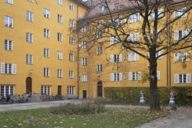
The Borstei housing complex is a listed residential district situated to the west of Munich. Created in the 1920s, it once served as a place of residence for the wealthier bourgeoisie. To this day, it retains a certain village character thanks to its shops, service providers and winding courtyards.
The Borstei housing complex is far off the beaten tourist tracks and yet it is well worth paying a visit to the district located to the west of Munich, given its unique status in the city – and perhaps even throughout Germany. This is because architect and building contractor Bernhard Borst, who had the residential estate built on Dachauer Strasse between 1924 and 1929, also designed Germany's first central heating system. The apartments therefore not only had a high degree of comfort thanks to central heating, but also running hot water and even heated garages.
The architect's vision at that time: Offer relief to housewives and afford them more time to be spent together with others in the neighbourhood. Therefore, Borst also provided a grocery service, a vacuum cleaner and domestic staff hiring service, rooms dedicated to carpet dust removal, a laundry service where tenants would see their items of clothing returned clean to them within a day, and a canteen where whole meals could be ordered.
Bernhard Borst purchased the near 90,000 m² property for 18 million Reichsmark (German currency at that time). After the tender for a suitable architect resulted in some good ideas being brought to the table – but ultimately no winner – Borst went on to plan his residential location without further ado. He wanted to “combine the beauty of a family home with the practicality of an apartment” – and so 70 apartment buildings comprising over 770 apartments were then built. The name originates from another competition, for which over 2,500 name suggestions were submitted - including “Borstei”.
It is not surprising that suggestions such as “paradise” made their way into the draw, given that at the time the residential quarter was considered to be just that – with all its innovation and luxury for inhabitants to enjoy. The two- to five-room apartments were equipped as standard with parquet flooring, bidet and telephone – consequently, these in part magnificently decorated places were the preserve of the upper middle class.
But the architect Borst also allowed befriended artists to move into some of the quarter's studios and apartments. Art was important to him – something that can still be seen in the various sculptures and statues, as well as the frescoes that appear on the buildings. Likewise, the building contractor attached great importance to nature, an aspect most generously integrated into the Borstei: details include a pond, several fountains and plenty of green – a mere 20 percent of this area has been built on. Borst implemented his brand new concept, which revolved around building the apartments around the gardens. The idea came to him while in the gardens of Schloss Schleissheim (Schleissheim Palace). In addition, the selection of flora seems almost stately: the Borstei housing complex is also home to botanical exotics such as the Japanese pagoda tree.
Only high-quality materials were used during its construction, while the health of its residents remained in focus: Borst laid the foundations using materials from his own brick factory near Freising and the sawmill in Thalkirchen (district). The building process also incorporated oak from Slovenia, marble from Ruhpolding, Treuchtlingen and Solnhofen and limestone from Kehlheim. The founder himself lived in the Borstei housing complex and also organised a string of concerts – such as with the Münchner Kammerorchester (Munich Chamber Orchestra) – as well as summer festivals and carnival parties for children.
Many of these festivals have survived to this day, as has the fundamental idea that Borstei residents can congregate and spend time together in the housing complex itself. Once you enter the quarter, you are overcome by the feeling of finding yourself in a small world of its own – or perhaps even a village. The old houses and courtyards are interconnected by passages, while any repair work carried out today strictly adheres to the standards of yesteryear.
And even its own infrastructure has stood the test of time: a post office, two kindergartens and medical practices. The residents of the Borstei have law firms, photographers, insurance companies, architects and shops right on their doorstep. Today, the range includes a delicatessen, a butcher's, a pharmacy, a goldsmith, a bakery, a shoemaker, a sewing shop, a hairdressing salon, a Lederhosen (traditional Bavarian leather shorts) store known as “Lederhosenwahnsinn” (leather pants madness), as well as pedicure and cosmetics providers, a beer and cocktail bar and the Café Borstei.
The Borstei housing complex even has its own museum now, which opened in 2006 and exhibits both the quarter’s concept and its history, as well as information on the architect himself and life in the settlement. Moreover, it is the smallest museum in Munich! Today, getting to the Borstei is a piece of cake when taking public transport: The tram lines 20 and 21 both go to the “Borstei” stop; when arriving at the Westfriedhof underground station, it is just a few minutes on foot.